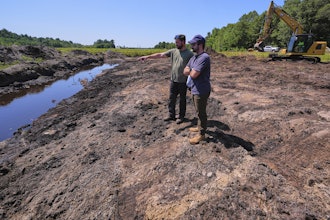
HANOI, Vietnam (AP) — An extreme weather phenomenon known as the dzud has killed more than 7.1 million animals in Mongolia this year, more than a tenth of the country's entire livestock holdings, endangering herders' livelihoods and way of life.
Dzuds are a combination of perennial droughts and severe, snowy winters and they are becoming harsher and more frequent because of climate change. They are most associated with Mongolia but also occur in other parts of Central Asia.
Many deaths, especially among malnourished female animals and their young, occur during the spring, which is the birthing season. Herding is central to Mongolia's economy and culture — contributing to 80% of its agricultural production and 11% of GDP.
In Mongolian, the word dzud means disaster. Dzuds occur when extremely heavy snows cause impenetrable layers of snow and ice to cover Mongolia's vast grasslands, so the animals cannot graze and they starve to death. Drought at other times of the year means there's not enough forage for the animals to fatten up for the winter. Dzuds used to occur once in a decade or so but are becoming harsher and more frequent because of climate change. This year's dzud is the sixth in the past decade and the worst yet. It followed a dzud last year and a dry summer. Snowfall was the heaviest since 1975.
The toll on Mongolia's herds has soared, with 2.1 million head of cattle, sheep and goats dead in February, rising to 7.1 million in May, according to state media.
Thousands of families have lost over 70% of their entire herds. And the total death toll may increase to 14.9 million animals, or nearly 24% of Mongolia's total herd, said Deputy Prime Minister S. Amarsaikhan, according to state media.
Nomadic herding is so vital for resource-rich Mongolia's 3.3 million people that its constitution refers to the country's 65 million camels, yaks, cattle, sheep, goats and horses as its "national wealth." Livestock and their products are Mongolia's second-largest export after mining, according to the Asian Development Bank.
High costs for fuel, food and fodder made the situation much worse for herders like Gantomor, a 38-year-old herder in mountainous Arkhangai province. Like many Mongolians, he goes by one name.
Warnings of a dzud prompted Gantomor to sell his entire flock of about 400 sheep. He only kept his sturdier yaks and horses, hoping that that he'd be able to take them to pastures that wouldn't be as badly affected.
Even after spending more than $2,000 to transport the remaining 200-odd animals 200 kilometers (124 miles) to a place he thought would be safer, he didn't escape the dzud. Seventy yaks died and 40 horses left the herd, leaving him with less than 100.
Batdelger's brother-in-law was better off than others. A friend had all but 15 of her 250 yaks die. The Mongolian countryside was filled with hundreds of carcasses, piling up in the melting snow, she said.
Disposing of the carcasses quickly to ensure they don't spread diseases is another big challenge. By early May, 5.6 million, or nearly 80%, of the dead animals had been buried.
The dzud is a perfect example of how interlinked climate change is with poverty and the economy, she said. Herders who lose their herds often migrate to cities like the capital, Ulaanbaatar, but find few opportunities for work.
Mongolia needs help but it also needs to adapt to dzuds with strategies such as better weather forecasting and measures to stop overgrazing. Herders need to diversify their incomes to help cushion the impact of livestock losses.
Khandaa Byamba, 37, a camel herder who lives in Dundgobi province in Mongolia's Gobi Desert said in an online interview that she has learned from her elders and also the hard experience of repeated dzuds.
Seeing early signs of yet another dzud, she let her camels wander, relying on their own instincts to find pastures. The family earlier decided to just herd camels to cope with climate change, drought and deteriorating pastures that have been turning into deserts. Khandaa Byamba's husband followed the animals for the first 100 kilometers (62 miles) while she stayed behind with some younger animals.
As the snow piled up, other families reported losing scores of animals. But after the winter, most of her camels returned. They only lost three adult camels and 10 younger ones in their herd of more than 200.





















